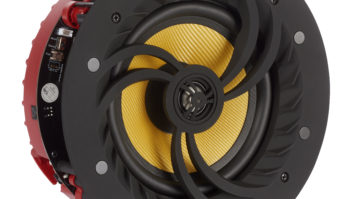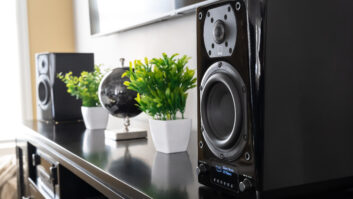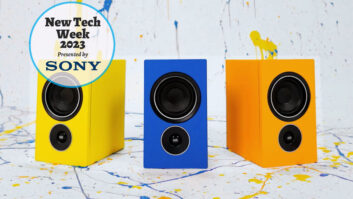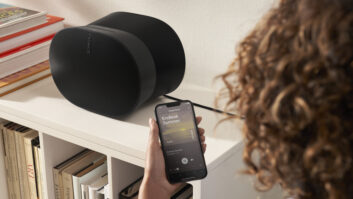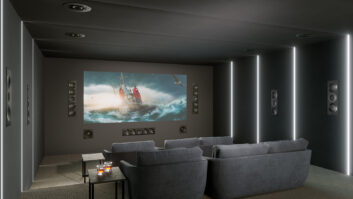When it comes to having rock-and-roll street cred, it’s tough to find someone more legit than Rikki Farr. Back in the day, Farr worked with such legends as Led Zeppelin, John Lennon, The Who, Jimi Hendrix, and Miles Davis. He even orchestrated a “little” thing called the Isle of Wight Music Festivals, which brought in more than 650,000 people for its multi-day music jams. So, yeah, Farr has been around the music biz and, more importantly, understands how a speaker should replicate sound. Exactly the kind of guy you’d like as the founder and chief creative officer of a speaker company.
RIVA Audio started back in 2014 with the idea of making a better-sounding wireless speaker. The result was the highly regarded Turbo X. But Bluetooth has its limitations, not just in sound quality, but in range—two qualities that seriously reduce its effectiveness for house-wide audio applications. Continuing with their original intention, RIVA launched its new WAND (Wireless Audio Network Design) series of “multi-room +” wireless speakers that not only offer better range and improved sound via Wi-Fi, but with an open architecture that fits consumers’ modern lifestyle needs.

Where most other wireless audio systems—Sonos, Play-Fi, Bluesound, HEOS, MusicCast, Nuvo—require a proprietary app, RIVA chose to embrace Google’s Chromecast architecture for multiroom operation. However, not wanting to “limit” people to Chromecast, WAND also supports Apple AirPlay, Bluetooth, DLNA, and Spotify Connect, and handles a variety of audio codecs, including FLAC up to 24-bit/192kHz. The result is a unique system that lets you access and play music in virtually any way you prefer to interact with it. (In line with being the everyman speaker, RIVA is working on developing third-party interfaces with popular automation systems.)
[Henry Clifford says ‘Stop Wasting Your Clients’ Time’]
This means people continue using apps they are familiar with, simply selecting what they want to hear and then “casting” it to the desired speaker or speaker group. This also means that people are always using the latest version of a given app without waiting for any updates if a streaming provider should change something.
Another benefit of using Chromecast is that it works across multiple speaker brands. For example, I could group in the Sony HT-ST5000 Atmos soundbar (review online at residentialsystems.com) with the RIVA speakers, letting me quickly build-out a house-wide music experience. Moreover, WAND works with Google Home, meaning that you can “Hey, Google” some music to the speaker. (This requires a Google Home product with built-in microphone.)
Currently, there are two speakers in the WAND series, the ARENA and FESTIVAL. However, at CES RIVA launched its new CENTRAL, a wireless 55-watt/channel stereo amplifier that connects to any existing passive speakers. This will greatly expand the WAND system, especially for custom integrators who can use CENTRAL to power in-wall/ceiling speakers around a home.

Each speaker features a USB connection that can either accept a drive to play music from or be used to charge a phone. Both speakers include a 3.5mm analog input, and the FESTIVAL adds a Toslink optical input. With its full-range sound, this could easily be used to connect a television’s audio output and function like a soundbar. There is an optional battery pack for the ARENA that delivers up to 20 hours of use. I brought the ARENA in with me to work on multiple occasions–plopping it down on the filing cabinet next to my desk–and I can attest to its lengthy battery life. Further, the speaker is “splash resistant” for outdoor use. Both speakers also include an Away switch on the rear panel that allows you to link multiple speakers together when no Wi-Fi is available.
The speakers look sharp, available in black with titanium accents, or white with silver. They also feature top-mounted controls for play/pause, skip ahead/back, and volume up/down. A nifty LED ring illuminates in multiple different colors to indicate the source currently playing. Moving around the FESTIVAL lets you know it has some serious build quality with its 14.2-pound heft. This comes not only from its 10 drivers (six active, four passive radiators), and 200 watts of six-channel amplification, but also its high-quality MDF wood enclosure, designed to limit any resonance that can discolor the sound. Also nice is that the ARENA’s rear panel has a threaded post for wall or stand mounting, and the FESTIVAL has dual-mounting posts on the bottom for use with the company’s optional stand.
Initial setup requires using the Google Home app, which locates the speakers, and walks you through connecting to Wi-Fi and naming the speakers. Listening on multiple speakers at once requires creating speaker groups, which is also done in the Google app. (Listening to multiple sources at once–say Pandora in the bedroom and Tidal in the kitchen–requires multiple devices.)
It’s easy enough to create and name multiple group combinations, but in practice I found this to be far more cumbersome than simply adding or subtracting rooms on the fly. Especially since switching from one speaker or group to another stops the music currently playing. Further, as you add additional speakers, the number of possible combinations quickly becomes unmanageable; four speakers avails 15 possible combinations, while five offers 31! RIVA feels that integrators will help homeowners create lifestyle groups such as “living,” “dining,” or “entertain” that will include all of the speakers desired for that scene, but I still prefer the ability to quickly pick and choose the rooms to add.
Another limitation to multi-speaker streaming is that you cannot use the app to adjust the volume of individual speakers, just the overall group volume. Of course, you can adjust volume independently at the speaker directly, but for a wireless, house-wide audio system, this is a real miss. I’m hoping that Google addresses both of these issues, pronto!
The RIVA WAND app is useful for selecting additional music listening options such as streaming from a media server, the USB drive, content directly from the device, as well as selecting the inputs on the speaker, or putting it into Bluetooth mode. Interestingly, while I was free to use my phone to do whatever I wanted—make calls, play games, etc.—without affecting anything playing while casting via Tidal, Spotify, or Pandora, if I used the microphone on my phone while streaming from my NAS drive or connected USB, the music would abruptly stop. RIVA said this was a known iOS restriction. (I didn’t have an Android device to use during testing.)

The WAND app is also used to adjust DSP settings and bass and treble. Here you can pair two ARENAs together in a left/right duo, or place it into “Power” mode that give you additional SPL horsepower at the expense of the speaker’s default Trillium setting. Trillium, for those unfamiliar, is the company’s patented three-channel audio technology that is used to enlarge the audio soundstage and create a more stereo-sounding experience from a single speaker.
The result is audio that is nothing short of impressive, even shockingly so at times. I went through a library of well-known tracks to see how the speakers would perform, and they never disappointed. The ARENA reproduced the bass notes from Rebecca Pigeon’s “Spanish Harlem” with aplomb, delivering texture and detail, with the Trillium design producing the air and ambience of the recording space. On bigger and bassier tracks the ARENA did an admirable job delivering a full-range experience, but there’s a limit to what you can expect from sub 3-inch drivers, and while the ARENA could fill even a moderate-sized space without going into distortion, when you really want to get down and feel the music, it couldn’t compete with the FESTIVAL’s palpable low-end and massive output.
I truly appreciated Trillium’s wider soundstage when compared directly against the dominant force in the wireless market: Sonos. I played the ARENA next to a Play:1 and the FESTIVAL alongside a Play:5. In both cases, the difference in image width was huge. Listening to Miles Davis’ “So What” on the ARENA made it clear the drummer was positioned stage right.
It would be sugarcoating it to say that Google Chromecast isn’t without its quirks, but that is software, which can be fixed and continually improved with updates. What you can’t fix is a lousy sounding speaker, and fortunately this isn’t an issue that RIVA has to worry about.


